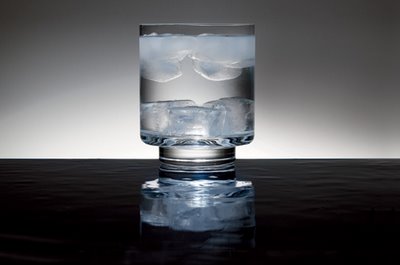Device uses waves to “print” on water surface
Researchers at Akishima Laboratories (Mitsui Zosen), working in conjunction with professor Shigeru Naito of Osaka University, have developed a device that uses waves to draw text and pictures on the surface of water.
The device, called AMOEBA (Advanced Multiple Organized Experimental Basin), consists of 50 water wave generators encircling a cylindrical tank 1.6 meters in diameter and 30 cm deep (about the size of a backyard kiddie pool). The wave generators move up and down in controlled motions to simultaneously produce a number of cylindrical waves that act as pixels. The pixels, which measure 10 cm in diameter and 4 cm in height, are combined to form lines and shapes. AMOEBA is capable of spelling out the entire roman alphabet, as well as some simple kanji characters. Each letter or picture remains on the water surface only for a moment, but they can be produced in succession on the surface every 3 seconds.
Researchers at Akishima Laboratories have developed similar devices in the past that used waves to draw pictures on the surface of water, but those devices had trouble producing letters with straight lines (such as the letter K). Additionally, it took the previous devices up to 15 minutes of data input time to produce each letter.
The newly developed technology uses improved calculation methods for controlling the wave generators, relying on formulas known as Bessel functions. In addition to being able to draw letters consisting of straight lines, the input time has been drastically reduced to between 15 and 30 seconds for each letter.
Akishima Laboratories expects the technology to be incorporated into amusement devices that combine acoustics, lighting and fountain technology, which they hope to see installed at theme parks and hotels.
[Source: Fuji Sankei]
[12:50 AM
|
]
[10:19 PM
|
]
USB Web Cam With Telescope So you live next to Keira Knightley. To broadcast her bathroom window live on the internet, the gadget you need to pull off this feat is a USB Web Cam with a Telescope. The Telescope has 7x magnification and 18mm in diameter. Resolution of this USB Web Cam is 800x600px, but it only reaches 30fps at 320x240px. Brando sells this USB gadget for $26.00.
So you live next to Keira Knightley. To broadcast her bathroom window live on the internet, the gadget you need to pull off this feat is a USB Web Cam with a Telescope. The Telescope has 7x magnification and 18mm in diameter. Resolution of this USB Web Cam is 800x600px, but it only reaches 30fps at 320x240px. Brando sells this USB gadget for $26.00.
[5:49 PM
|
]
Ice Capades
Ice is supposed to float, but with a little heavy water, you can make cubes that sink
By Theodore Gray
Make Sinking
IceCost: $65
Time: 2 Hours
Mode Safe
Ice is supposed to float, but with a little heavy water, you can make cubes that sink
By Theodore Gray
Make Sinking
IceCost: $65
Time: 2 Hours
Mode Safe
Want a surefire bet for your next cocktail party? First, tell your guests that aquatic life—at least in temperate climates—depends largely on the fact that ice floats. If it sank, lakes would freeze solid instead of forming an insulating layer of ice on top, killing all the fish. Now bet that you can magically make an ice cube sink. Grab one from a glass of special cubes you've strategically placed nearby, and drop it into a cup of ordinary water. Collect your guests' money.

The key to the trick is heavy ice. Many terms shouldn't be taken literally—a red quark isn't red, a peanut is neither a pea nor a nut—but heavy water is exactly what it sounds like: water that weighs more than normal. This is possible because elements occur in several different forms, or isotopes, made up of atoms with the same number of protons and electrons (which determine their chemical properties) but a variable number of neutrons (which contribute weight but not much else).
Hydrogen atoms always have one proton and one electron, but only one in every 6,400 has a neutron that nearly doubles the atom¹s mass. Using a complex process called H2S, it¹s possible to isolate this heavy hydrogen, also known as deuterium (D), creating water that¹s about 10 percent heavier than normal.
Chemically, D2O—as it's written—is real water. Algae can grow and thrive in pure heavy water. Specially raised mice have contained as much as 25 percent heavy hydrogen; beyond that level, subtle biochemical reactions make the heavy mice sick. (Researchers used mice because they are small. Raising a heavy cow would be expensive.)
Heavy water's primary use is in nuclear reactors, but it is not itself radioactive. It's safe to handle (although drinking it is not recommended, so keep it out of your guests' glasses) and easy to buy from your neighborhood isotope supplier (try unitednuclear.com). For about $15 a cube, you can make your own sinking ice and win that bet every time—unless you're entertaining nuclear scientists.
Find more on Gray's experiments at periodictabletable.com and at popsci.com/graymatter

